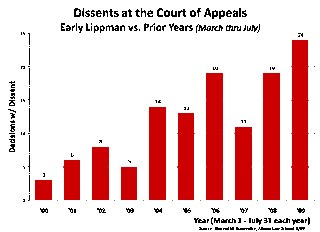Meanwhile, New York's highest court finished its winter/spring session and went on summer break. There's plenty to examine. Not only regarding the winter/spring session, but the entire 2008-2009 year. For the next few posts, however, let's look at that winter/spring session. Specifically, let's look at developments since Jonathan Lippman was sworn in as Chief Judge on February 25.
Some interesting and important developments to be sure.)
Dissents, and the divided decisions that they create, have been on the increase. As discussed in a series of posts around this time last year, the number of dissents at the court had more than doubled in recent years. The doubling coincided with the appointments of Judges Susan Read and Robert Smith, in 2003 and 2004 respectively, and the resulting majority of Pataki appointees on the court. (Cites/links below.)
The dissents have not abated with the new Chief Judge. Instead, they have increased even more. Indeed, the number of dissents from March through July (which represent the cases since Lippman's first full session of oral arguments) was higher than the number for any other such period in any recent year. Substantially higher than the number for most years. And notably higher than the number for the last few years which, in turn, were considerably higher than for the preceding years. In short, a significant increase in dissents.
Here's a graph that shows it.
GRAPH 1
Dissents in the (early) Lippman Court
(click to enlarge)

As Graph 1 shows, the number of dissents in Lippman's first few months as Chief Judge is the highest for any like period depicted. The number began in the low to middle single digits in the first few years of the decade It then doubled that in the years immediately following the appointments of Judges Read and Smith (i.e., 2004 & 2005). And it jumped again this past year with Lippman at the helm.
Many questions arise. One of them is: Who's been doing the dissenting?
We've seen in the earlier posts that Judge Robert Smith was a frequent dissenter. Judge Susan Read, although not as often as Smith, had been dissenting more than others on the Court. Also, we noted that Judge Eugene Pigott seemed more than willing to break with the majority of his colleagues as soon as he joined the Court. No rookie effect for him. As for Chief Judge Judith Kaye, we saw that she dissented quite infrequently.
Let's see how the Judges of the Court did with the new Chief. And how he did as well.
GRAPH 2
Who's Dissenting in the (early) Lippman Court?
(click to enlarge)

Graph 2 depicts both the number of dissenting opinions each Judge wrote since Lippman became Chief, and the total number of dissents--written or joined--during that period.
Judge Smith leads his colleagues in written and total dissents. He's followed by Judge Pigott.
Interestingly, in contrast to what we've seen from Judge Read over the previous several years, she was not one of the leading dissenters in this early Lippman period. And speaking of Lippman, he was in dissent more frequently than any of his colleagues other than Smith and Pigott. (That's a big change for the Judge seated in the center. We'll return to that shortly.)
Let's reorganize the graph in descending order of dissenting frequency. (I.e., from highest to lowest--and that reminder is for my benefit as much as anyone else's.)
GRAPH 3
Dissenters in the (early) Lippman Court (descending order)
(click to enlarge)

Again, same data, just reorganized. Nothing new.
But this reordering of the Judges does make particularly vivid the wide spectrum of dissenting frequency. From Judge Smith to Judge Victoria Graffeo. An extraordinary difference. Perhaps reflecting an extraordinary difference in how they view the value of dissents--as much as how frequently they each actually agree with the majority's position. Is a disagreement with the majority worth a dissent? Is unanimity, acquiescence, and collegiality more important than expressing one's differing position? No doubt these two Judges have very different views on those questions.
And what about the new Chief and the old? As again depicted in Graph 3, Lippman has not been an infrequent dissenter in his first few months on the Court. How does his record compare with that of his predecessor?
The following graph adds Chief Judge Kaye's dissenting record for the same period last year (i.e., March through July 2008). Her record is depicted immediately adjacent to Lippman's for the contrast.
GRAPH 4
Dissenters in the (early) Lippman Court, with Kaye
(click to enlarge)

Could the contrast be more stark? Kaye, a firm believer in as much unanimity, as frequently, as possible, dissented much less frequently last year than Lippman did this year. In fact, Kaye dissented less last year than any Judge on the Court dissented this year. As Chief Judge, Kaye typically dissented infrequently. Last year was not out of the ordinary for her. (Her record was discussed along with those of her colleagues in those previous posts about dissents at the Court. The cites/links are given below.)
Soooo, dissents are up at the Court of Appeals. They're up from where they were already up! They're up from last year--Chief Judge Kaye's last year on the Court. And they're up for the new Chief Judge compared to what they were for his predecessor.
No honeymoon for Lippman? Or maybe he simply doesn't put as high a premium on unanimity as Kaye did.
In any event, the next posts will look a little more closely at the dissents and dissenters, what their individual and collective records may tell us, how those records compare with those from the past few years, and what the changes might signify.
(The doubling of dissents in recent years was explored on New York Court Watcher in New York Court of Appeals: More Dissents in Kaye Court (Part 3: Read and Smith; and Pigott Too), July 23, 2008; (Part 2: Who? How Many? What?), July 10, 2008; More Dissents in Kaye Court, June 28, 2008.)